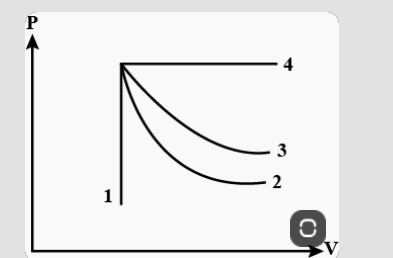An ideal gas undergoes four different processes from the same initial state (Figure Four processes are adiabatic, isothermal, isobaric and isochoric. Out of 1,2,3 and 4, which one is adiabatic?
 Solution in Punjabi
Solution in Punjabi
4
3
2
1
Step by step video & image solution for An ideal gas undergoes four different processes from the same initial state (Figure Four processes are adiabatic, isothermal, isobaric and isochoric. Out of 1,2,3 and 4, which one is adiabatic? by Physics experts to help you in doubts & scoring excellent marks in Class 11 exams.
Topper's Solved these Questions
Similar Questions
An ideal gas with pressure P, volume V and temperature T is expanded isothermally to a volume 2V and a final pressure Pi, If the same gas is expanded adiabatically to a volume 2V and a final pressure Pα find the value of ratio PαPi. The ratio of the specific heats for the gas is 1.67.
02:28View SolutionWhat is the value of Rydberg constant?
01:25View SolutionDefine unit
06:29View SolutionAn ideal gas undergoes four different processes from the same initial state (figure). Four process are adiabatic, isothermal, isobaric and isochloric. Out of 1, 2, 3, and 4 which one is idabatic.
01:25View SolutionAn ideal gas undergoes for different processes from the same initial state (figure). Four processes are adiabatic, isothermal, isobaric and isochoric. Out of 1, 2, 3 and 4 which one is adiabatic ?
View SolutionThe given diagram shows four processes i.e., isochoric, isobaric, isothermal and adiabatic. The correct assignment of the processes, in the same order is given by:
04:22View SolutionAn ideal gas undergoes for different processes from the same initial state (figure). Four processes are adiabatic, isothermal, isobaric and isochoric. Out of 1, 2, 3 and 4 which one is adiabatic ?
 03:06View Solution
03:06View Solutionएक परमाण्विक आदर्श गैस (monatomic ideal gas) का एक मोल (one mole), चार ऊष्मागतीय प्रक्रमों (thermodynamic processes) से गुजरता है, जैसा कि नीचे PV व्यवस्था चित्र (schematic diagram) में दर्शाया गया है। यहाँ दिये गये प्रक्रमों में एक समदाबीय (isobaric), एक समआयतनिक (isochoric), एक समतापीय (Isothermal) और
03:15View SolutionWhat are isobaric, isochoric, isothermal and adiabatic processes?
02:45View SolutionAn ideal gas undergoes four processes: isochoric, isobaric, isothermal and adiabatic. In which process is (i) the change in internal energy zero?
03:11View SolutionAn ideal gas undergoes four processes: isochoric, isobaric, isothermal and adiabatic. In which process is (ii) the work done zero?
02:30View SolutionAn ideal gas undergoes four processes: isochoric, isobaric, isothermal and adiabatic. In which process is (iii) the heat exchange zero?
02:54View SolutionAn ideal gas undergoes four different processes from the same initial state as shown in figure of P-V diagram. Four processes are adiabatic, isothermal, isobaric and isochoric. Out of 1,2,3 and 4 which one is adiabatic ?
03:37View SolutionAn ideal gas undergoes for different processes from the same initial state (figure). Four processes are adiabatic, isothermal, isobaric and isochoric. Out of 1, 2, 3 and 4 which one is adiabatic ?
 04:12View Solution
04:12View SolutionThe given diagrams shows four processes i.e., isochoric , isobaric , isothermal and adiabatic. The correct assignment of the processes in the same order is given by:
 View Solution
View SolutionAn ideal gas undergoes for different processes from the same initial state (figure). Four processes are adiabatic, isothermal, isobaric and isochoric. Out of 1, 2, 3 and 4 which one is adiabatic ?
42:10View Solution

